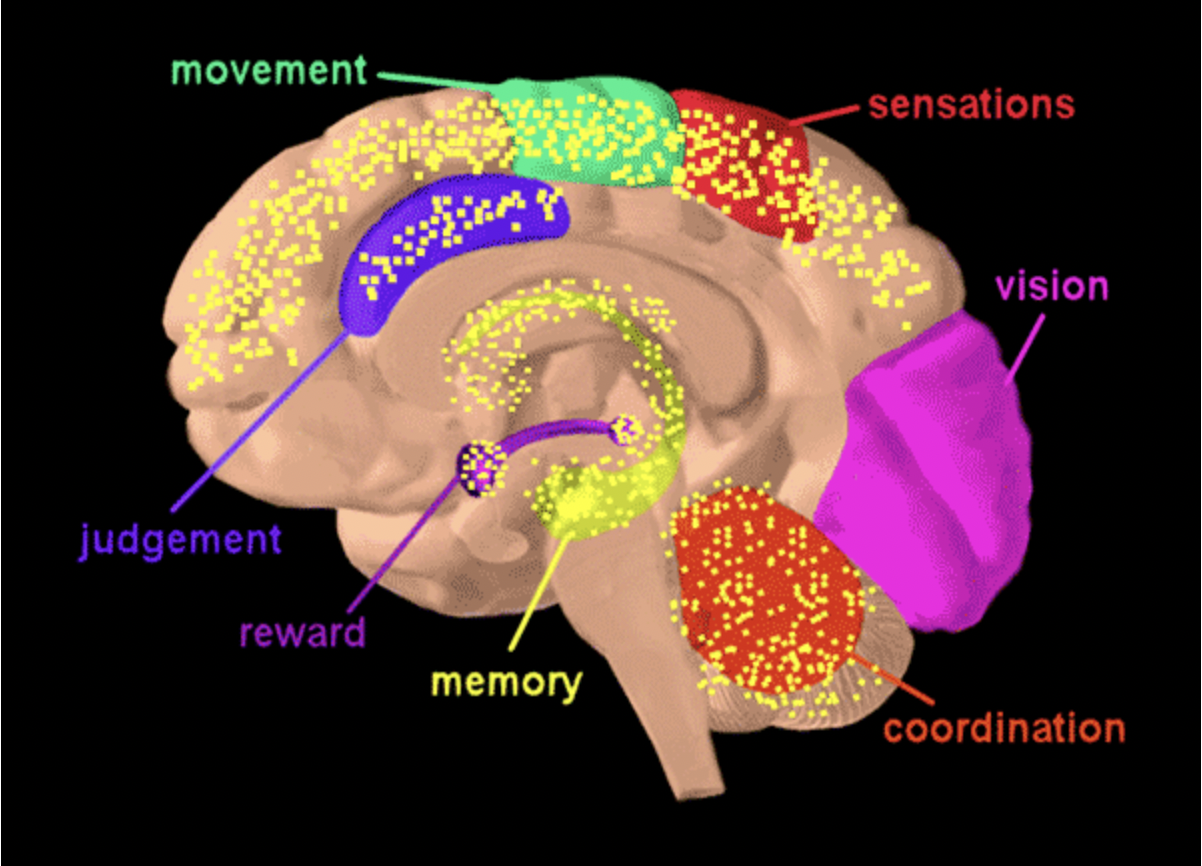Possible therapeutic effects of cannabis
Psychoactive drugs such as THC and CBD contain synthetic ligands for receptors called CB1 and CB2, which makes them a possible therapeutic approach for central nervous system (CNS) disorders. An article by Kendall et al. explains CB1 receptors as the most abundant GPCRs in the CNS and bind to the main active ingredient of marijuana (2017). Because of this, they play a major role in the endocannabinoid system which is vital for various processes in the brain such as pain, perception, learning, mood, etc. This system can also provide neuroprotection and modulate neuroplasticity and neuroinflammation. THC contains a psychoactive molecule that activates CB1 receptors, which may be neuroprotective and inhibit neuroinflammatory factors, specifically through β-arrestin, a scaffolding protein that carries out various CB receptor signaling pathways (Figure 1). This type of treatment has potential in neurodegenerative diseases such as Huntington’s and Alzheimer’s disease where CB1 expression is reduced, and the endocannabinoid system is altered [1]. However, there are few treatment options available through cannabis, partly because of the risks of overuse and addiction.
Figure 1. β-arrestin signaling pathways [2].

Short term effects of THC
When an individual smokes THC, it passes through the lungs and into the bloodstream where it travels to the brain and other organs in the body. When someone eats or drinks cannabis, however, it is absorbed much more slowly. This spreading of specific molecules throughout the body creates the “high” that people feel due to the activation in the brain where the most CB receptors are (Figure 2). The symptoms include altered senses, sense of time, mood, movement, and more. The individual may also have a raised heart rate for up to three hours after using the drug [3]. Each of these symptoms are organized into a tetrad response with four categories of effects from the CB1 agonists in THC which include (1) Hypolocomotion, a decrease of horizontal activity (2) Hypothermia, decreased body temperature (3) Catalepsy, an impaired ability to initiate movement (4) Analgesia, decreased pain sensitivity [4].
Figure 2. Areas of the brain with an abundance of CB1 receptors [3].

Long term effects of THC
THC contains addictive properties which may lead to cannabis use disorder if used too often. To be diagnosed with this disorder, the patient must meet 2/11 DSM-5 criteria which include the inability to reduce consumption, constant cravings, and relationship and social problems due to using the drug [5]. For those who continuously smoke THC, lung and breathing problems similar to those from tobacco may occur. Moreover, memory and attention deficits, hallucinations, paranoia, and worsened symptoms in individuals with schizophrenia may occur, linking long term use to mental illness. Attention, memory, and problem solving can be altered in children whose mother used THC while pregnant as well. Furthermore, regular vomiting, nausea, and dehydration caused by cannabis use has been termed Cannabinoid Hyperemesis Syndrome [3].
Treatment or dangerous?
Overall, due to the synthetic ligands in THC that bind to CB receptors, this psychoactive drug may be a therapeutic approach for CNS disorders due to these receptors’ roles in neuroprotection, inflammation, and plasticity. However, more research must be done on how to add and dose these specific molecules in useable and safe medications. Moreover, other drugs from cannabis, such as CBD, may be better suited for therapeutic purposes because of its differing effects [1].
References
[1] Kendall, D. A., & Yudowski, G. A. (2017). Cannabinoid Receptors in the Central Nervous System: Their Signaling and Roles in Disease. Frontiers in Cellular Neuroscience, 10, 294. https://doi.org/10.3389/fncel.2016.00294
[2] Nogueras-Ortiz, C., & Yudowski, G. A. (2016). The Multiple Waves of Cannabinoid 1 Receptor Signaling. Molecular Pharmacology, 90(5), 620–626. https://doi.org/10.1124/mol.116.104539
[3] Abuse, N. I. on D. (2019, December 24). Cannabis (Marijuana) DrugFacts | National Institute on Drug Abuse (NIDA). https://nida.nih.gov/publications/drugfacts/cannabis-marijuana
[4] Metna-Laurent, M., Mondésir, M., Grel, A., Vallee, M., & Piazza, P.-V. (2017). Cannabinoid-Induced Tetrad in Mice: Cannabinoid-Induced Tetrad. In Current protocols in neuroscience / editorial board, Jacqueline N. Crawley … [Et al.] (Vol. 2017, p. 9.59.1-9.59.10). https://doi.org/10.1002/cpns.31
[5] Cannabis/Marijuana Use Disorder. (n.d.). Yale Medicine. Retrieved April 12, 2024, from https://www.yalemedicine.org/conditions/marijuana-use-disorder
